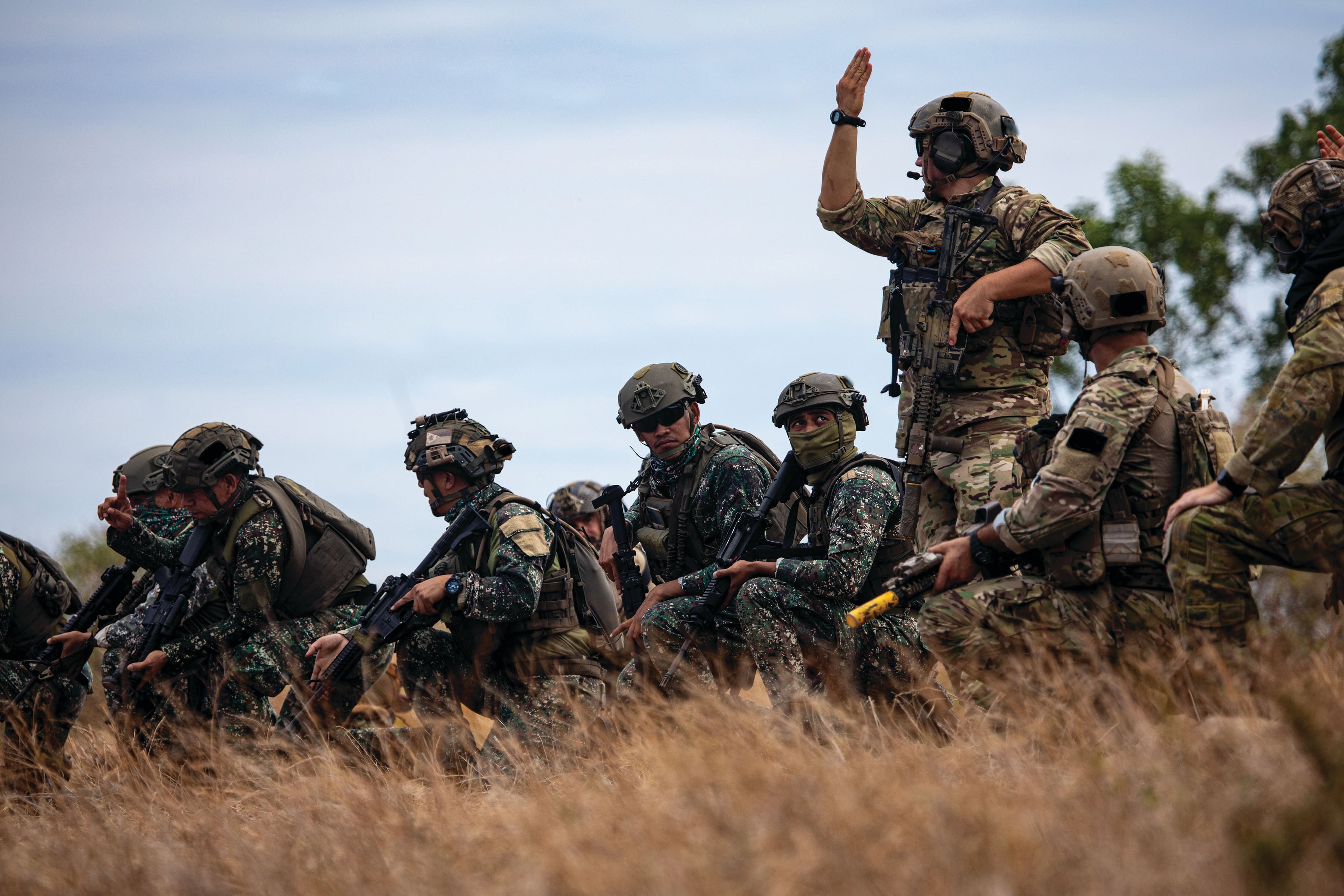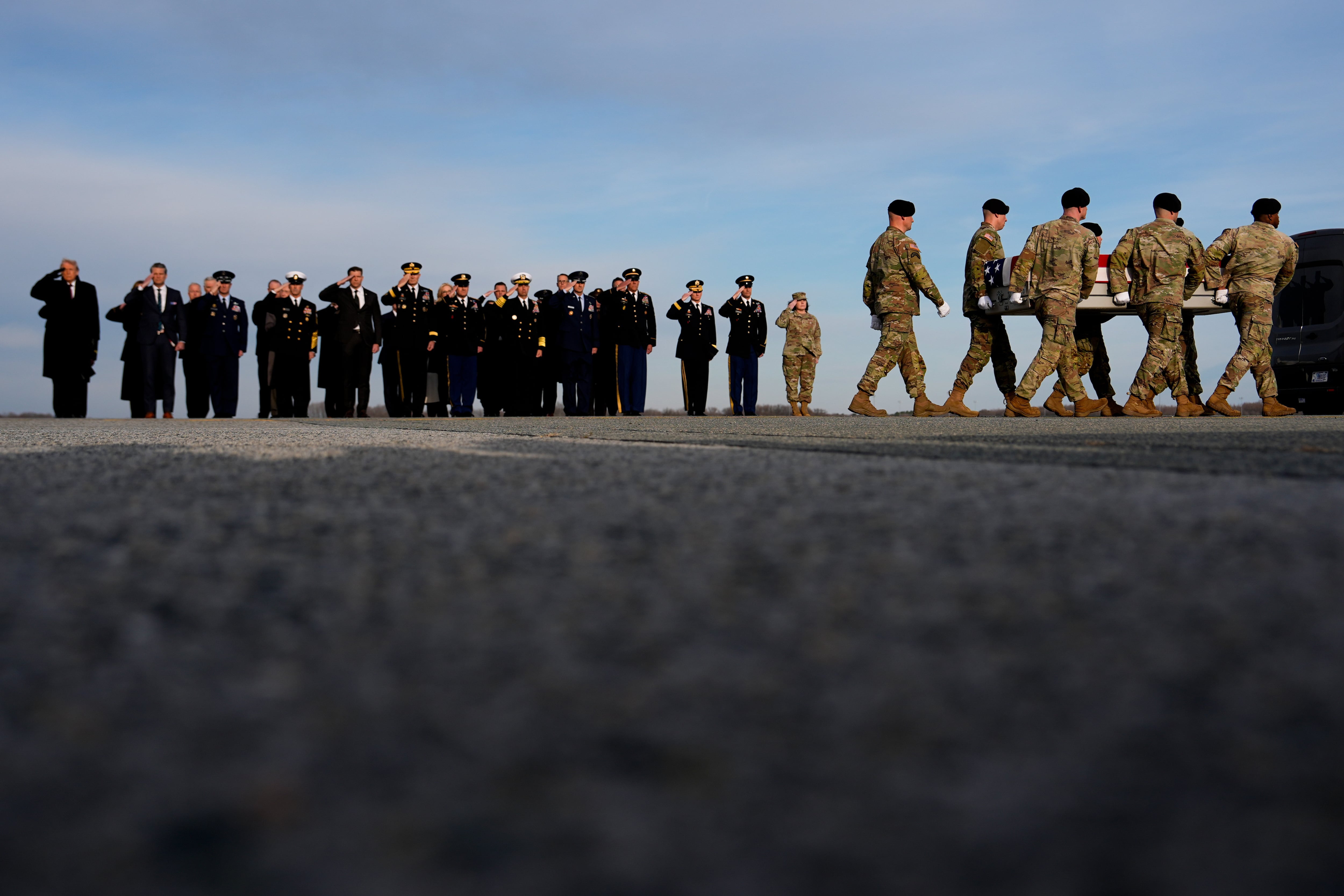WASHINGTON — The distinctive patch of the Army’s Special Forces units dates back to 1955, when Capt. John W. Fry of the 77th Special Forces Group reportedly submitted a design he felt reflected the new units’ all-domain mission.
According to Army heraldry officials, the three lightning flashes represent the elite troops’ ability to “strike rapidly by air, water or land.”
Nearly 70 years later, the service’s top special operations leader sees a resonance between that original all-domain concept and the “modern day” deterrence triad of space, cyber and special operations that senior leaders unveiled in recent months. The military’s top space official, Gen. James Dickinson, dubbed it the “influence triad” when he unveiled the concept in August.
The influence triad is intended to complement the nuclear triad. Where the nuclear triad deters a foe’s strategic forces, like inter-continental ballistic missiles, the influence triad is intended to deter and help respond to irregular activity that stops short of armed conflict, and then dominate foes in those domains when a war begins.
And to implement it, Army Special Operations Command is weighing force structure changes at every echelon, new technology-oriented career fields and new ways to harness talent both already existing in the Army’s reserve components and in the civilian population.
“If there had been five domains at that time, I don’t think these gentlemen [who established Army special operations] would have said, ‘Well, we’re not going to care about these other two domains,’” quipped Lt. Gen. Jon Braga, who commands USASOC.
RELATED
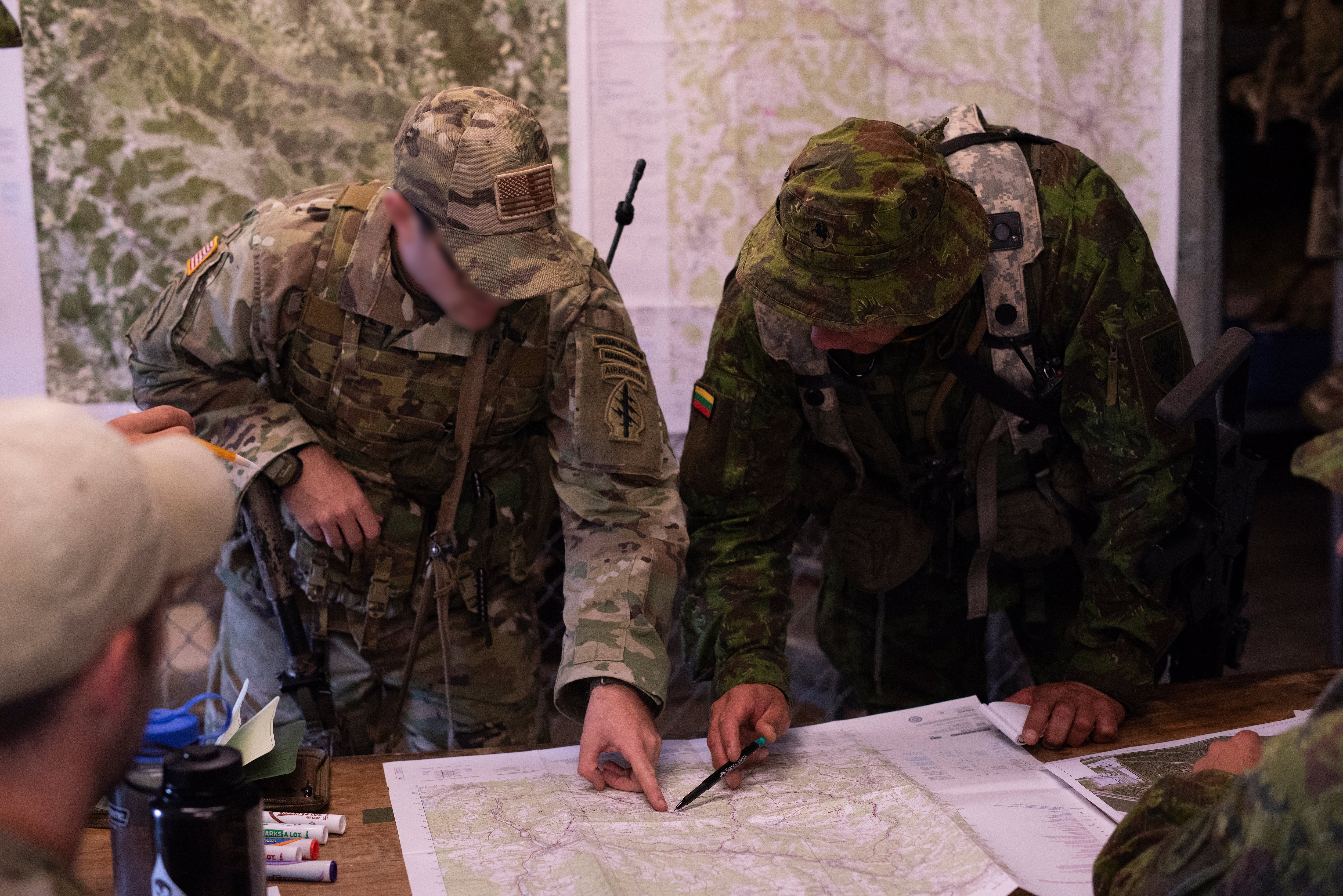
Braga sat for an exclusive interview with Army Times Oct. 11 during the annual Association of the U.S. Army conference in Washington, D.C., where he also participated in panels and press conferences.
Braga and his colleagues atop the Army’s space and cyber warfare communities see the triad concept as “simply taking what our capabilities are and applying them in a combined arms model...no different than bringing together maneuver, fires, aviation” and other capabilities to meet objectives, as Lt. Gen. Daniel Karbler of Space and Missile Defense Command described it.
But because their capabilities are well-suited to operations meant to counter foes in situations short of armed combat, the influence triad is likely to play a major role in implementing the recently released National Defense Strategy.
The new strategic guidance stresses “integrated deterrence” through “campaigning,” which prioritizes building — and messaging — advantages for the next war in a manner that deters countries like China from even firing a shot.
For Army special operations, retooling for that mission after decades of emphasis on counterterrorism and direct action raids is simultaneously a return to its roots and a step into the unknown.
To Braga, it’s an “evolution” for SOF.
What can the new triad do for SOF?
Ukraine’s success thus far in fighting off Russia’s massive invasion, which began in February, has offered some vindication for recent special operations concepts and valuable lessons for SOF troops who will be training partner nation forces in the years ahead.
One example is the Resistance Operating Concept, which advocates building the capacity of friendly countries to respond to invasion by waging an effective resistance behind enemy lines should their conventional militaries prove unable to hold all of their territory. When the ROC playbook is implemented, the resistance aims to tie up enemy resources and help lay the groundwork for a later liberation counter-offensive.
Army Times featured the ROC on the cover of its September 2021 print edition, and later revealed how U.S. and NATO officials — including SOF elements — had helped Kyiv to implement key portions of the gameplay in the years preceding the invasion.
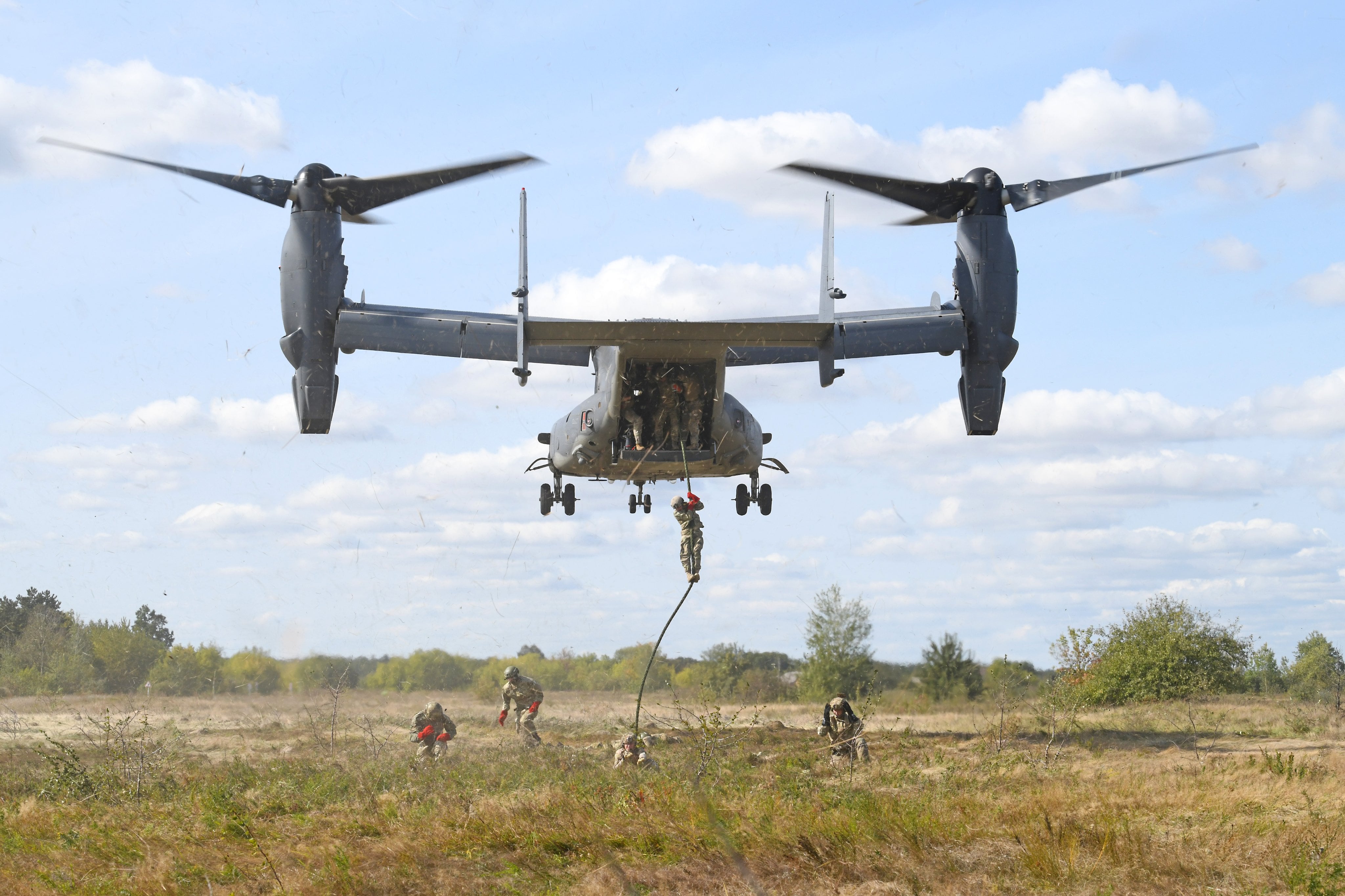
But what surprised many observers was how technology- and space-oriented the Ukraine government’s resistance plans proved to be, as well as how commercially-available those capacities are.
Braga, SMDC’s Karbler and others are noticing.
Satellites from Hawkeye 360, a radio frequency analytics company, detected Russian electronic warfare efforts months before the fight. SpaceX’s Starlink satellite internet allowed isolated Ukrainian troops in Mariupol and other areas to resist for longer. Commercially available imagery was available in near real-time.
Ukraine also launched a resistance coordinating website early in the war, with practical handbooks and tips on how to securely spot and report enemy troop locations for those who may not be able to participate in armed resistance.
Karbler highlighted the impact of coordination between U.S. military space assets, the private sector and Ukraine’s government as a lesson worth emulating.
RELATED
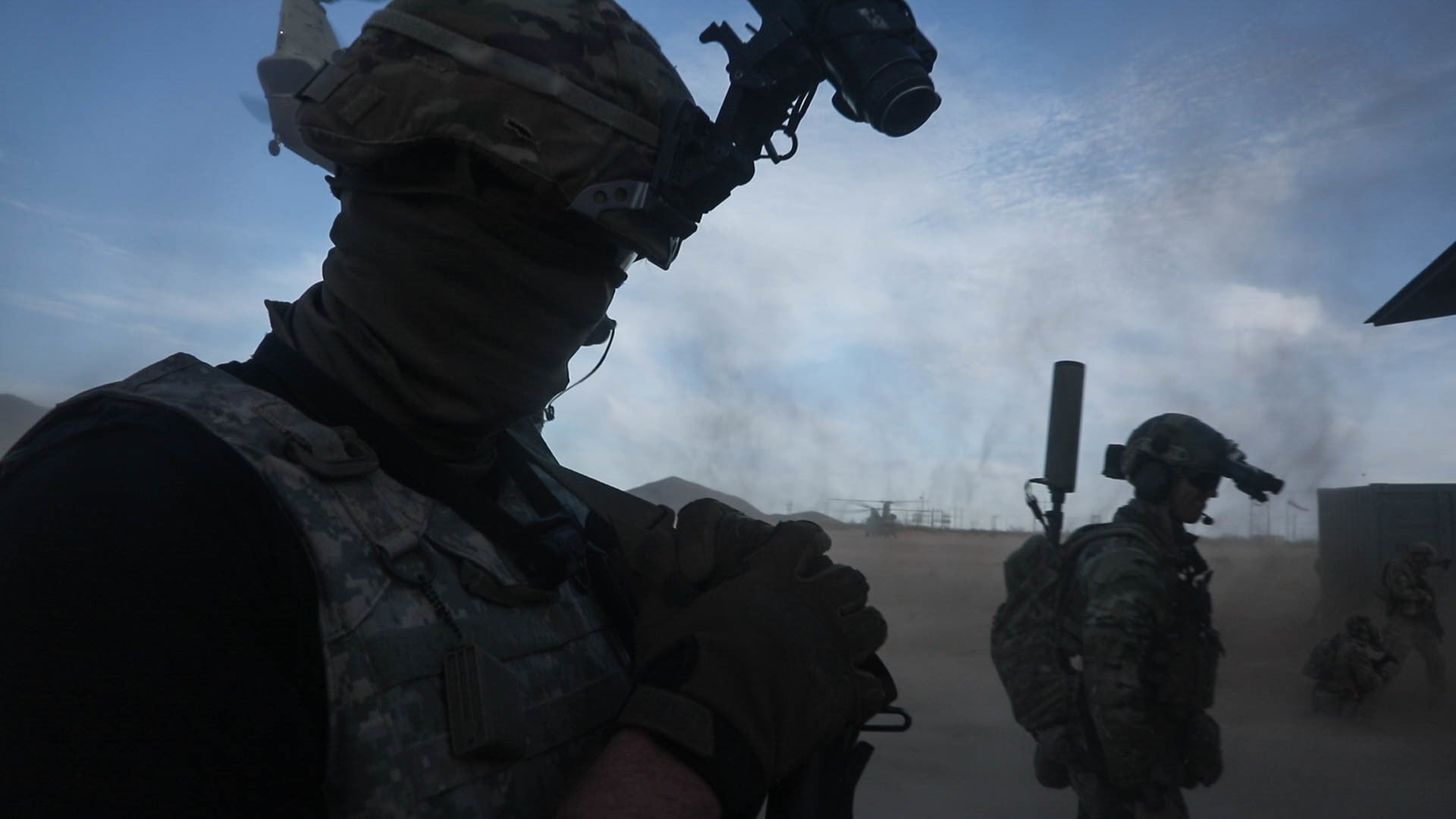
“Even if a nation-state doesn’t have the budget to be launching their own satellites...[they’re] becoming very accessible for all entities,” said Braga. “That can provide capability in an unconventional warfare standpoint where you might have a behind enemy lines situation where cyberspace might be able to deliver an effect or deliver information in [occupied] physical areas.”
Asked about how the multi-domain ROC lessons from Ukraine are being applied in other counties, Braga said, “We are in discussions with countries — both countries that are well-resourced and have a space program, and some that don’t — [that are] still looking at how to leverage both cyber and space on [their] special operations forces.”
But as Army SOF moves into closer concert with space and cyber capabilities, having the right people with the right training organized so they’re in the right place at the right time to do their job is even more important than hardware.
How might force structure change?
Army officials, including Braga, have previously acknowledged that a service-wide analysis is underway to determine how to integrate basic tech capacity (like the small unmanned drones ubiquitous in Ukraine) at the tactical level.
Part of that will necessitate changes to force structure from the unit-of-action level all the way to the top, Braga argued. These changes will ensure that SOF is prepared for “irregular warfare campaigning...[and] high-end conflict,” Braga said.
“For the last 20 years, there’s been very few instances where we have deployed as designed...we’ve always augmented,” added Braga. “So if we have deployed for 20 years — never as is — is our force design correct? I think [the question] answers itself.”
During public remarks at the conference, the USASOC commander revealed that officials are considering “at the brigade or battalion headquarters level...realigning ARSOF” to include representation from all three parts of Army special operations: special forces, civil affairs and psychological operations.
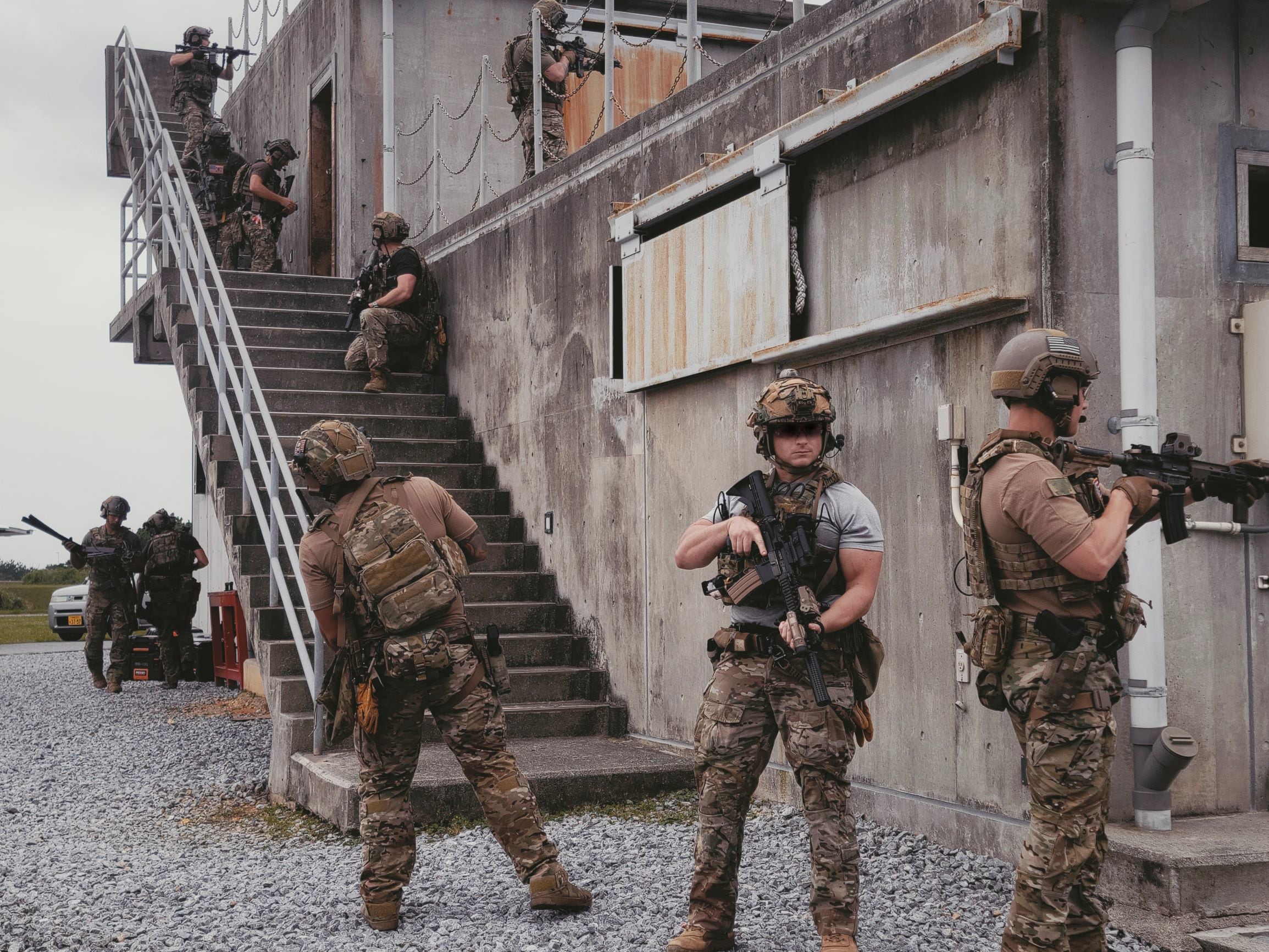
Special Forces formations could see the biggest tactical-level changes. For years, SF companies have been organized with six 12-soldier teams known as ODAs, short for Operational Detachment-Alpha, and a headquarters element or Operational Detachment-Bravo.
Now, said Braga, “there’s one company in each Special Forces Group experimenting with a 16-man team and a convergence headquarters that [in] some cases is at the company level...[and] in some cases at the battalion level.”
Connecting Vets first reported units were experimenting with a 16-soldier ODA concept, but the extent of the pilot was not previously known.
Asked what the extra four team-level operators would bring to the table, the USASOC commander suggested he’d want more technology-oriented roles added to the fight and pointed to the command’s ongoing experiment with developing warrant officers focused on tactical-level “tech integration.” It’s not clear, though, whether these troops would represent all four additional soldiers in the experimental ODA.
New warrant officer career field?
A new, proposed warrant officer career field would focus on roles like “drone operator, drone integrator, drone builder, robotics, manned-unmanned teaming, leveraging artificial intelligence, coding, tactical cyber” and more, Braga previously told Army Times. He doesn’t think these jobs should be heaped upon an ODA’s existing communications sergeants, who have quietly become overburdened with systems and capabilities.
“We can do more with a dedicated professional where that’s their job, not just an additional duty,” the general explained in the interview.
“I cannot envision a future form of warfare that does not employ more need for robotics, unmanned systems, artificial intelligence and machine learning,” Braga said. “We have people who are passionate and capable in those skillsets — people who build their own drones, have self-taught Python [code]...these people exist in our formation right now, but we don’t have an institutional pipeline to provide them a successful career.”
Some opportunities exist to help troops who already have those skills to expand and use them, but they’re few and far between. A handful of Army special operators are currently assigned to the Army Software Factory in Austin, Texas, where they’re working on an upgraded suite of apps for the Android-powered devices that SOF units carry into battle.
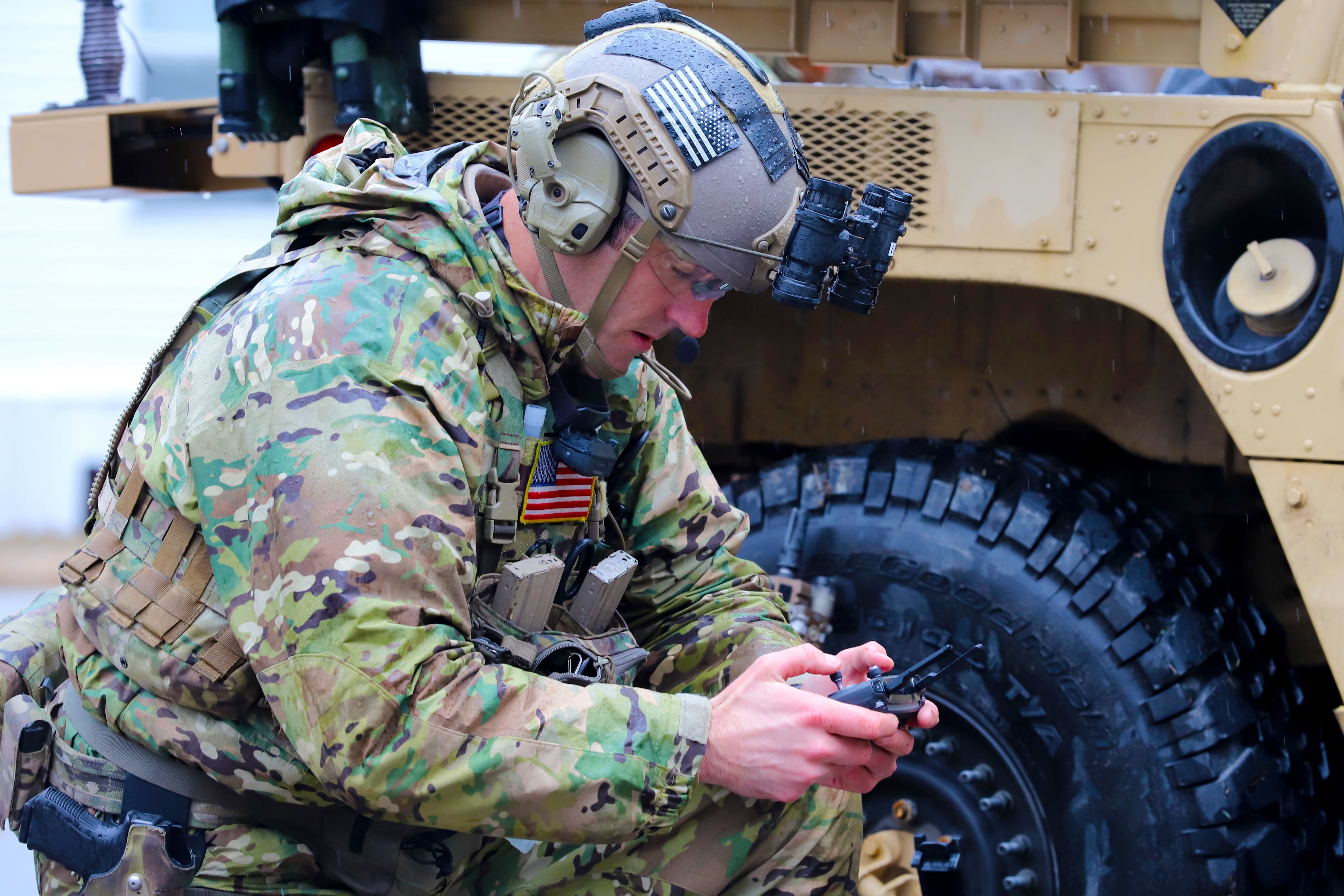
Army Times spoke with them about their work and career path during a September visit to the facility. During the visit, Futures Command requested — and Army Times agreed — not to name individual coders from the unit in order to protect their privacy and encourage them to speak candidly.
One SF warrant officer there said ODAs have a similar innovative spirit to the Software Factory, but acknowledged that he volunteered for a tour in Austin because the SOF community lacked “a clear [career] path that I could go forward in.”
But he’s been hearing from senior leaders in recent months about the proposed career field, and he thinks there’s an opportunity for “value added” on the teams if the plan is effectively implemented.
It’s not clear whether the proposed career field would be within the Special Forces branch, which would require soldiers to make it through an assessment and selection process and the Special Forces Qualification Course. Braga indicated that officials are analyzing whether that’s the best path.
The SF warrant assigned to the Software Factory expressed worry that tech-focused troops at the ODA level may be set back culturally if they’re not required to go through the full training pipeline.
“If they haven’t gone through that [training process],” he explained, team members may be concerned about the tech troops not “being able to keep up, go for it in the middle of the mountains or...[keep] cool when it’s jumping [and] things aren’t going very well.”
Part-time PSYOP?
But when it comes to other special operations capabilities, there’s not always a need for that lengthy training. Nor is it always necessary for the soldiers to wear the uniform full-time — Braga suggested a reconsideration of how the Army’s reserve component troops support the special operations community.
Currently, the Army Reserve has a significant number of traditional drilling civil affairs and psychological operations units, but the soldiers in them are not required to attend selection courses. National Guard troops assigned to the 19th and 20th Special Forces Groups go through the full SF training pipeline.
“We are in discussions with [the Army Reserve and Army National Guard]...about force experimentation,” explained Braga. “We have to leverage the talent that’s in the Guard and Reserve as part of [a] total Army analysis [and] rebalance.”
While the discussions are preliminary, Braga said he can “envision” a revamped version of part-time special operations built around “a combined National Guard/Reserve element that maybe is based out of Northern California [or] Washington State.”
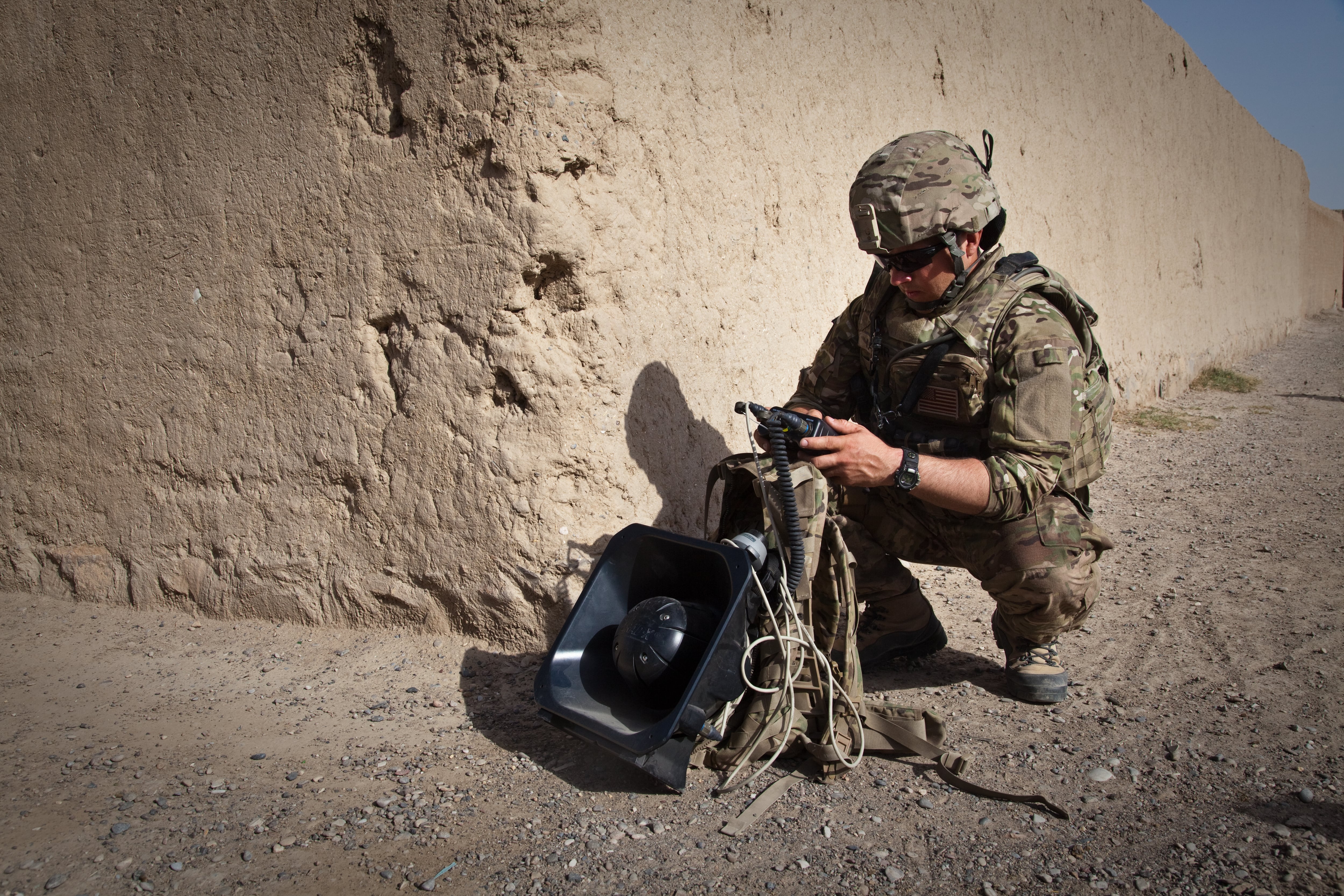
He acknowledged concerns that many traditional Guard and Reserve soldiers aligned with existing units struggle to maintain a true part-time relationship with the Army, saying “we need to be more creative” than shoehorning SOF training and missions into part-time units.
Otherwise, Braga added, SOF is missing out on “talent in [the] reserve and National Guard that doesn’t exist in the active duty force, because their civilian careers actually keep them up to the state of the art of their craft — could be writing, could be coding, could be hacking.”
“I envision [continental United States]-based operational support, maybe even state-based support, where they don’t need to come to Fort Bragg, or they might not even need to deploy overseas to do some of their jobs — specially when you’re talking psychological operations,” Braga explained.
Even for traditionally expeditionary capabilities like civil affairs, the general argued that technology allows for “AI-enabled and internet-based civil reconnaissance” now and might enable some troops “to stay in [their] home state and work from a terminal node.”
Braga argued it’s because many key skills valued in influence and information operations, like writing, broadcast, production, drawing and graphic design, can be done from nearly anywhere.
Finding the right recruits
Braga also believes that there’s more top-flight talent out there in America’s streets and schools who can help fill PSYOP roles and contribute to the tech integration efforts, but the service needs to reach them.
“I could walk in any high school in America and I could say, ‘I’ve got a role for you in Army Special operations,’” he remarked to reporters during the AUSA conference.
“[If] you’re STEM-focused and you like coding, I’d love you to come on and be the baddest drone builder [or robotics expert] in the world. Please come join us,” he said. “If you are more on the humanities side...[and] psychology-focused or work on designing sets as part of the theater club, we’ve got a spot for you in psychological operations.”
But in order to fully tap into these prevalent skills, Braga added, the command needs “different standards for different things out there” and the pathways to bring talent in and continue developing it.
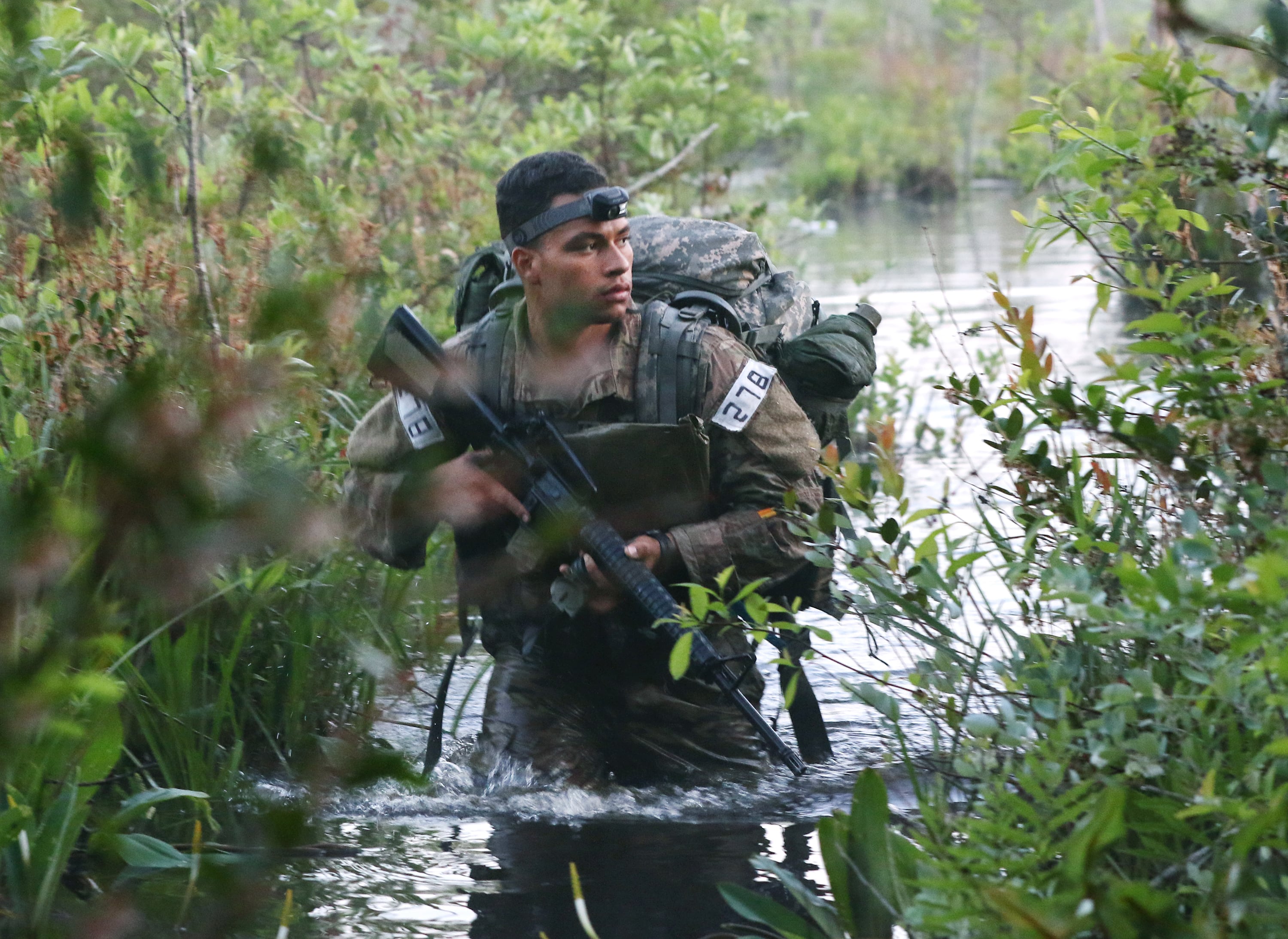
The model already exists for attracting Special Forces candidates. The 18X program allows prospective soldiers to enlist with a guaranteed opportunity to attend Airborne School and Special Forces Assessment and Selection.
A direct entry program for PSYOP troops also launched in recent years, but Braga confided, “We’ve got to do a better job of translating those opportunities for not only high-schoolers, but...[also] people already in the workforce out there.”
He said prospective soldiers often have “no clue...[they] can have a career” revolving around the key skills PSYOP troops exercise.
Part of the disconnect, he fears, lies in the name.
“If I just said, ‘Hey, you want to come and be a psychological operations operator?’ some people are like, ‘What are you talking about?’” he explained. “But if I went in and said, ‘Hey, do you want to be a military social media influencer?’ I think I know what you told me just there.”
With the new influence triad offering opportunities to reconsider long-held assumptions, Braga thinks there’s something for every young American in his formations.
C4ISRNET reporter Colin Demarest and Federal Times reporter Molly Weisner contributed reporting.
Davis Winkie covers the Army for Military Times. He studied history at Vanderbilt and UNC-Chapel Hill, and served five years in the Army Guard. His investigations earned the Society of Professional Journalists' 2023 Sunshine Award and consecutive Military Reporters and Editors honors, among others. Davis was also a 2022 Livingston Awards finalist.
